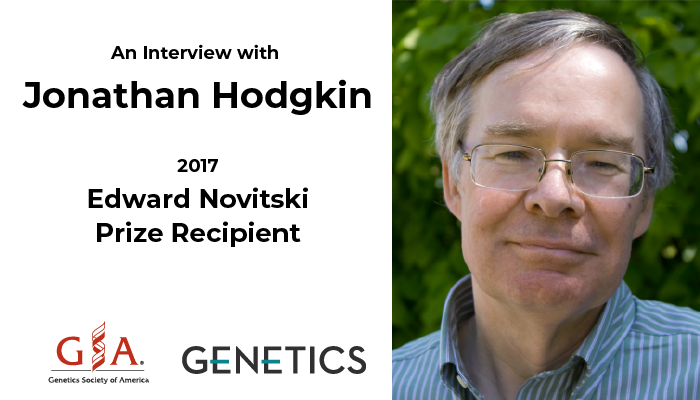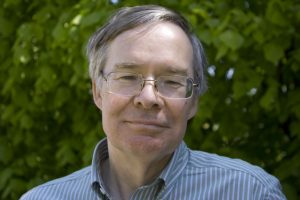The Genetics Society of America’s Edward Novitski Prize recognizes a single experimental accomplishment or a body of work in which an exceptional level of creativity and intellectual ingenuity has been used to design and execute scientific experiments to solve a difficult problem in genetics.
The 2017 winner, Jonathan Hodgkin, used elegant genetic studies to unravel the sex determination pathway in Caenorhabditis elegans. He inferred the order of genes in the pathway and their modes of regulation using epistasis analyses, a powerful tool that was quickly adopted by other researchers. He expanded the number and use of informational suppressor mutants in C. elegans, which are able to act on many genes. He also introduced the use of collections of wild C. elegans to study naturally occurring genetic variation, paving the way for SNP mapping and QTL analysis, as well as studies of hybrid incompatibilities between worm species. His current work focuses on nematode-bacterial interactions and innate immunity.
This interview was published in the December 2017 issue of GENETICS.
What inspired you to become a scientist?
I was exposed to research from a very early age and learned a great deal from my father and grandfather. My father was Alan Hodgkin who was a physiologist and neurobiologist, and my mother’s father was Peyton Rous, who was a virologist who discovered the Rous sarcoma virus. I had various other scientific relatives —cousins and what have you—going further back. I wouldn’t say it was inevitable that I became a scientist, but it was the easiest career option! And of course, I was inspired by the people who taught me at university, from about second-year onwards, who were enormously influential.
Why did you choose C. elegans as your research system?
Very largely because of Sydney Brenner. He gave a lecture that I heard as an undergraduate, and I thought that here was a great system for investigating the things in biology that I thought were really, really interesting. So, when I graduated I went and persuaded Brenner take me on, and he —somewhat reluctantly—did. He was inspirational and brilliant in all ways, truly extraordinary. And it was indeed a great system. It has gone off in all sorts of directions and keeps on generating new lines of research and new amazing discoveries.
What’s the most memorable moment from your career so far?
Probably when I realized the spectacular effect of a particular mutation on sex determination in C. elegans. It was a dominant mutation that caused the animal to change sex completely, and I’d previously found mutations in the same gene that caused the absolutely opposite transformation. It was just astonishing to realize that with that one gene you control everything about the animal’s sex. This was a very satisfying and elegant result, which came together in a fairly short time.
Who have been your most important mentors?
At university, I was very lucky to be taught directly by a superb yeast geneticist, Brian Cox, whom I much admired. He did a lot of things that were underappreciated; for example, he discovered one of the systems that turned out to involve a yeast prion. He made it clear to me how immensely powerful genetics is. Then as a grad student, Sydney Brenner obviously, but also other people at the MRC Laboratory in Cambridge, like molecular biologist Mark Bretscher, who was very influential and full of good advice, and also inspirational people like Francis Crick. Francis was the only person smarter than Sydney at the MRC Lab!!
What types of questions are you fascinated by?
The big questions in development. Looking back on it now, I think what got me into research —and what I thought C. elegans was particularly powerful for—is a very difficult question that remains in many ways completely unanswered. How do you specify complicated behavior genetically? It’s obvious from all sorts of examples of instinctive behavior that they must be genetically programmed. How on earth do you do that? We have no idea whatsoever! We’ve made enormous progress in understanding development and the basis of the nervous system, but how do you do genetically specify things like the behavior of crows that can make tools out of bits of leaf? They don’t need to learn that! If you take a New Caledonian crow and allow it to hatch and grow up in isolation, after a while it will start finding bits of leaves and turning them into tools for picking up insects. I’m baffled by how such behavior can be generated, and I’d love to know the mechanism. C. elegans has such simple behavior that we may be able to eventually understand how it’s specified, though the more we more we learn about the worm, the fancier its behavior becomes. I don’t work in this area anymore, but the people who do are making nice progress. The most sophisticated aspects of it are still very mysterious though, and big questions remain unanswered.
What are you currently working on?
I’m working on how worms and bacteria interact with each other, and how the worms are able to fight off disease, how they recognize that they’ve got a disease, how infection happens, how some bacteria are able to infect some worms and not other worms. That involves a lot of interesting questions that still haven’t been answered, but it’s also led to lots of unexpected things along the way. For example, finding a bacterium that kills worms by causing them to stick together by their tails, but the worms can sometimes escape by dividing themselves in two. Nobody knew that nematodes s could do autotomy, so that was really surprising!
Autotomy raises questions about how they manage to do it. Unfortunately, so far, the half-worms survive but won’t regenerate. If you cut Planaria in half they will regenerate, but nematodes do not. Or at least we can’t get them to do it, which doesn’t necessarily mean it doesn’t happen.
If you hadn’t been a scientist, what would you have liked to have become?
Probably an archaeologist. I spent a lot of time hanging out with archaeologists on excavations until about the end of 1980s. Archaeology is like doing biological research in that you’re always discovering things, and it’s like genetics in that it’s open ended. The trouble with being an archeologist is there’s a factor of maybe 100 in the difference in employability between a biologist and an archaeologist.
What’s the best advice you ever received?
Perhaps what Mark Bretscher said to me, which was: everything depends on having a good assay. I think that this is true whatever kind of experimental science you do, and it’s something I’ve always kept in mind. Avoid assays that are too arduous. Sometimes you have no choice, but if you can, try to get a stringent assay and one that’s easy to do.
What advice would you give to younger scientists?
Hang in there. It has gotten harder. It would be hard to deny, both in terms of career prospects and in terms of some of the questions that are out there, that it’s not as easy to do research as once it was. But on the other hand, science goes on being enormously rewarding and enjoyable, and amongst other things there is a very strong community. You find yourself working with a lot of people who are interested in the same things and are all very bright, very funny, and very agreeable. That was the great thing about working at the Molecular Biology Laboratory in Cambridge: you instantly realized that it was a wonderful environment, nonhierarchical and dedicated and excited about research. Many other occupations can involve more or less going around in circles, or trying to solve incredibly difficult social problems. There aren’t many careers that go on being satisfying and fascinating in quite the same way as this one—or where you actually get to move back the frontiers of knowledge.
































